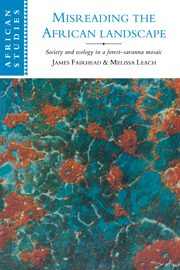Book contents
- Frontmatter
- Contents
- List of plates
- List of figures
- List of tables
- Note on authorship and research collaboration
- Acknowledgements
- Linguistic conventions
- Introduction
- 1 Convictions of forest loss in policy and ecological science
- 2 Forest gain: historical evidence of vegetation change
- 3 Settling a landscape: forest islands in regional social and political history
- 4 Ecology and society in a Kuranko village
- 5 Ecology and society in a Kissi village
- 6 Enriching a landscape: working with ecology and deflecting successions
- 7 Accounting for forest gain: local land use, regional political economy and demography
- 8 Reading forest history backwards: a century of environmental policy
- 9 Sustaining reversed histories: the continual production of views of forest loss
- 10 Towards a new forest–savanna ecology and history
- Appendix I Glossary of plant names
- Appendix II Cassette recordings of oral accounts and discussions
- Notes
- List of references
- Index
- Titles in the series
- Plate section
8 - Reading forest history backwards: a century of environmental policy
Published online by Cambridge University Press: 05 June 2012
- Frontmatter
- Contents
- List of plates
- List of figures
- List of tables
- Note on authorship and research collaboration
- Acknowledgements
- Linguistic conventions
- Introduction
- 1 Convictions of forest loss in policy and ecological science
- 2 Forest gain: historical evidence of vegetation change
- 3 Settling a landscape: forest islands in regional social and political history
- 4 Ecology and society in a Kuranko village
- 5 Ecology and society in a Kissi village
- 6 Enriching a landscape: working with ecology and deflecting successions
- 7 Accounting for forest gain: local land use, regional political economy and demography
- 8 Reading forest history backwards: a century of environmental policy
- 9 Sustaining reversed histories: the continual production of views of forest loss
- 10 Towards a new forest–savanna ecology and history
- Appendix I Glossary of plant names
- Appendix II Cassette recordings of oral accounts and discussions
- Notes
- List of references
- Index
- Titles in the series
- Plate section
Summary
We began this book by examining present perceptions of vegetation change current in scientific and policy circles. Subsequent chapters have shown how far these perceptions diverge from vegetation change as demonstrated by historical evidence and as experienced and perceived by villagers. In this mismatch it has become clear that, at a first approximation, policy-makers have been reading environmental history backwards. It is the case, however, that this backwards reading of forest–savanna dynamics in policy discourse is not new; indeed the basic elements of the derived savanna vision were in place from early in the colonial period. In this chapter, we trace chronologically how it was subsequently elaborated within Kissidougou's agricultural and forestry administrations during the colonial and post-independence periods to dovetail with emergent national and Africa-wide concerns.
This degradation discourse has had material implications, in the form both of policies and actions planned from it, and of less intentional, but no less instrumental, effects. Within the context of the other economic and political influences examined in the previous chapter, we now address more systematically the interaction between externally conceived environmental policies and changing local land-use practices. Given that the latter have been based on very different – even opposed – views of environmental change, it is not surprising that many aspects of this interaction have been problematic.
- Type
- Chapter
- Information
- Misreading the African LandscapeSociety and Ecology in a Forest-Savanna Mosaic, pp. 237 - 260Publisher: Cambridge University PressPrint publication year: 1996
- 1
- Cited by

